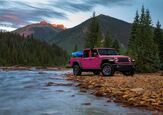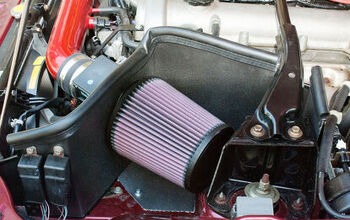How To Load A Trailer The Right Way
Towing a car might seem straightforward, but doing it safely and efficiently is all about the details.
Formula Drift champion Fredric Aasbo walks through the essential steps of properly loading a trailer using the 2025 Toyota Tundra and a GR Supra as the test case. Whether you're new to trailering or just need a refresher, here's what you need to know.
Can Your Truck Handle It?
The first consideration when towing is simple: Can your vehicle handle the weight?
The 2025 Toyota Tundra can tow up to 11,175 pounds, making it capable of handling a wide variety of loads. That said, when you start approaching the upper limits of a half-ton truck’s towing capacity, you should be using either a gooseneck trailer or a weight distribution system. For this setup—a standard hitch and a sports car—there’s more than enough headroom to tow with confidence.
Why Weight Distribution Matters
Once you're hitched up, the most important part of loading is proper weight distribution. Ideally, around 60% of the cargo should sit in front of the trailer axle, and the remaining 40% should sit behind. This helps keep the trailer stable and ensures the truck remains balanced and controllable.
But rules of thumb only go so far. For the most accurate setup, you’ll want to measure your tongue weight. Some modern hitches, like the one used here, feature built-in scales that allow you to dial in that number precisely.
Let’s Talk Numbers
Here are the key figures used in the example:
- Max tongue weight: 1,170 lbs
- Max payload: 1,605 lbs
- Gross trailer weight: 5,389 lbs (Supra + trailer)
- Target tongue weight (10-15%): 539 to 808 lbs
- Payload used: 739 lbs (including Fredric's 200 lbs and 539 lbs tongue weight)
As long as the tongue weight and overall payload stay within your truck’s specifications, you're in the clear.
Choosing the Right Hitch
Make sure you have the right ball mount for your setup. In this case, the Tundra has a 2-inch receiver, which pairs with a 2-inch ball on the trailer. Importantly, the ball mount must be rated to handle the trailer’s total weight. This one’s rated to 12,500 lbs, comfortably over the total being towed.
Hook Up Before You Load
It’s important to connect the trailer to your truck before loading any cargo. Loading beforehand can cause the trailer to tilt backward or become unstable, leading to potential damage or danger.
The Tundra’s built-in panoramic-view and hitch-view cameras make backing into position easier—even without a spotter.
Once the ball and tongue are aligned, you can:
- Lower the tongue onto the ball
- Engage the tongue lock and secure it with a pin
- Raise the trailer jack to its minimum height
- Cross and connect safety chains to form a cradle
- Plug in the trailer wiring harness
If your trailer has electric brakes, you’ll also need a 7-pin connector. The Tundra comes with an integrated brake controller, but aftermarket Bluetooth options are available.
Loading and Balancing
To illustrate why balance is crucial, Aasbo shows what happens when the car is loaded too far forward or backward. Too far forward causes the truck to squat and reduces steering traction. Too far back increases sway risk. A properly balanced load avoids both.
In this example, 659 lbs of tongue weight (just over 10% of the gross trailer weight, plus compensation for driver weight) is spot on.
Securing the Load
When it comes to strapping down the vehicle, there are two main methods:
- Preferred method: Wrap straps over the tires and through D-rings on a trailer with track systems.
- Alternative: Attach straps to the lower control arms and secure them to the trailer's D-rings.
Avoid crossing straps. Straight-line tension provides redundancy—if one fails, the others still hold. Compression-based methods (like through the wheels) can loosen on bumpy roads.
Use four points of contact—two front, two rear—for a secure hold. At the back, wrapping around the axle is another safe option if it aligns properly with the tie-downs.
One Last Touch: Load-Leveling
One new feature Aasbo highlights is the air suspension system on the 2025 Tundra. This allows the rear of the truck to self-level under load, improving overall balance and handling.
Wrapping It Up
And that’s how you load a trailer the right way. From calculating capacity to securing your load, every step matters. Stay tuned for more in-depth towing tips in upcoming videos—including how to calculate towing capacity for different setups and how to use alternative towing methods.
Become an AutoGuide insider. Get the latest from the automotive world first by subscribing to our newsletter here.
More by AutoGuide.com Staff




































Comments
Join the conversation
"As long as the tongue weight and overall payload stay within your truck’s specifications, you're in the clear."
Not always. Don't forget axle weights and weight distribution on the truck side. Most manufacturers ( I've owned GMC, Nissan, and Ram) say to measure the rise at the front kf the truck, NOT squat at the back. Some other factors. Tundra (and everyone else) owners should know the actual numbers for payload, axle weights etc specific to their truck. The mkre heavily optioned a truck is, the lower its payload - get these numbers from the sticker on the truck, not the manufacturers brochures, web site, etc. Eample: for the Ram 2500, Ram advertises a payload of UP TO 4000 pounds. Mine is a 4x4,crew cab, Laramie and its actual truck specific payload is 2939. The same truck with a diesel engine is only around 2200 and their are configurations that go as low as 1400. Finally, your trailer is a rather best case scenario. Your trailer must be very light to be under 5400 with the car in it. Also, if your picture is accurate, the trailer is much longer than the car which allows you to position the car perfectly to balance the trailer. I see a lot of people trying to pull travel trailers with 1/2 tons and that's a very different animal. You are limited to storing cargo where the manufacturer has space for it. Trailer manufacturers also sometimes locate things poorly. For example on mine, the 54 gallon fresh water tank is behind the axles. When I bought this, I had a Sierra 1500 with a payload of 1650 and with my trailer loaded to 7600, the iusual stuff we loaded in the truck (cause the camper didn't have to storage for it) plus a 106 pound weight distribution hitch and two people in the cab and we were over loaded. Many half tons would be way overloaded, especially if they added a couple of kids, the dog, etc.
make sure the trailer to hitch safety chains are crossed under hitch so if the trailer comes off off the ball or the ball or receiver come loose the trailer to catch the trailer tongue and not let it dig into the road,